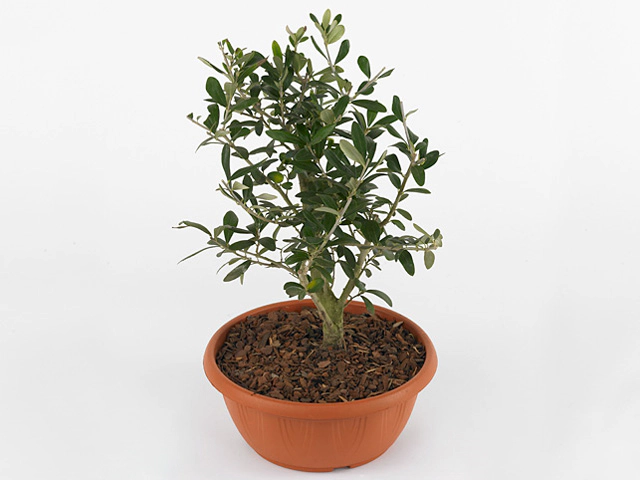Olea europaea

| Leaf arrangement | crosswise opposite |
| Leaf tip | Mucronate |
| Leaf margin | Entire |
| Leaf, general shape | Lanceolate |
| Leaf surface | Dull; Smooth |
| Leaf size | 5 - 7,5 cm |
| Leaf, main color | Dark green |
| Leaf colour, pattern | Unicolored |
The Olea europaea, commonly known as the olive tree, is a species that is native to the Mediterranean region. This evergreen tree is highly valued for its fruit, the olive, as well as for its ornamental value in gardens and landscapes. Its unique leaf characteristics make it easily distinguishable and appreciated by plant enthusiasts.
One of the first notable features of the Olea europaea is its leaf arrangement, which is crosswise opposite. This means that the leaves are positioned in pairs directly across from each other on the stem. This organized arrangement creates a beautiful symmetry in the tree's foliage.
The leaf tip of the olive tree is described as mucronate, which means it ends in a small pointed projection. This slight tapering at the end of the leaf adds an elegant touch to its overall appearance.
The leaf margin of the Olea europaea is entire, meaning it has a smooth, uninterrupted edge. This characteristic gives the leaves a clean and polished look.
In terms of shape, the olive tree's leaves are lanceolate, which means they are elongated and narrow, tapering at both ends. This lance-like shape adds a refined and graceful aspect to the tree's foliage.
The surface of the Olea europaea's leaves is described as dull and smooth. The dullness refers to the lack of shine or gloss on the leaf surface, while the smoothness adds a gentle and velvety texture to the touch.
The average leaf size of the Olea europaea ranges between 5 to 7.5 centimeters. This moderate size allows the leaves to capture sunlight efficiently while still maintaining an aesthetic appeal.
The general color of the olive tree's leaves is a rich, dark green. This lush hue is a characteristic that is often associated with the tree and adds to its overall allure. Additionally, the leaves of the Olea europaea are unicolored, meaning they have a consistent color throughout, without any distinct patterns or additional coloring.
In conclusion, the Olea europaea, or olive tree, possesses several distinctive leaf characteristics, including crosswise opposite arrangement, mucronate tips, entire margins, lanceolate shape, dull and smooth surfaces, 5-7.5 cm size, and a deep, dark green color with a unicolored pattern. These factors contribute to the overall beauty and appeal of this remarkable tree, making it a beloved species in various settings, from gardens to landscapes, and even in the agricultural industry for its highly valued fruit, the olive.
Market availability index by month:
| Jan. | Feb. | Mar. | Apr. | May | Jun. | Jul. | Aug. | Sep. | Oct. | Nov. | Dec. |
|---|---|---|---|---|---|---|---|---|---|---|---|
| 1 | 2 | 2 | 3 | 4 | 3 | 1 | 2 | 1 | 1 | 1 | 1 |